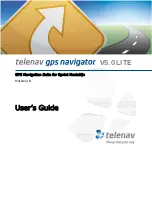
Introduction
Principles of Operation
Calculating Absolute Positions
17
www.javad.com
• Space – GPS, GLONASS, and Galileo satellites orbit approximately 12,000 nautical miles
above Earth and are equipped with a clock and radio. These satellites broadcast ranging
signals and various digital information (ephemerides, almanacs, time&frequency
corrections, etc.).
• Control – Ground stations located around the Earth that monitor the satellites and upload
data, including clock corrections and new ephemerides (satellite positions as a function of
time), to ensure the satellites transmit data properly.
• User – The community and military that use GNSS receivers to calculate positions.
1.1.2. Calculating Absolute Positions
When calculating an absolute position, a stationary or moving receiver determines its three-
dimensional position with respect to the origin of an Earth-Center Earth-Fixed coordinate system.
To calculate this position, the receiver measures the distance (called pseudoranges) between it and
at least four satellites. The measured pseudoranges are corrected for clock differences (receiver
and satellites) and signal propagation delays due to atmospheric effects. The positions of the
satellites are computed from the ephemeris data transmitted to the receiver in navigation
messages. When using a single satellite system, the minimum number of satellites needed to
compute a position is four. In a mixed satellite scenario (GPS, GLONASS, Galileo), the receiver
must lock onto five or more satellites to account for the different time scales used in these systems
and to obtain an absolute position.
1.1.3. Calculating Differential Positions
DGPS, or Differential GPS, is a relative positioning technique where the measurements from two
or more remote receivers are combined and processed using sophisticated algorithms to calculate
the receivers’ relative coordinates with high accuracy.
DGPS accommodates various implementation techniques that can be classified according to the
following criteria:
• The type of GNSS measurements used, either code-phase differential measurements or
carrier-phase differential measurements
• If real-time or post-mission results required Real-time applications can be further divided
according to the source of differential data and communication link used.
With DGPS in its most traditional approach, one receiver is placed at a known, surveyed location
and is referred to as the reference receiver or base station. Another receiver is placed at an
unknown location and is referred to as the remote receiver or rover. The reference station collects
the code-phase and carrier-phase measurements from each GNSS satellite in view.
Содержание TRIUMPH-1
Страница 2: ...www javad com ...
Страница 14: ...Preface Related Information Technical Assistance 14 www javad com ...
Страница 26: ...Introduction Option Authorization File OAF Storage Precautions 26 www javad com ...
Страница 94: ...Receiver and File Maintenance Loading New Firmware Sleep Mode 94 www javad com ...
Страница 136: ...Configuration Examples RCV RAW Client Configuration Example Rover Configuration 136 www javad com ...
Страница 156: ...UHF Radio Usage 156 www javad com ...
















































